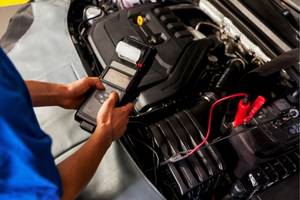Introduction
If you want your Ford to run smoothly, you need to review one important element: the Engine Control Module (ECM). A healthy ECM makes sure optimal vehicle performance. Wondering how to diagnose Ford ECM repair needs? You've arrived at the right place! This guide will help you identify possible issues with your Ford ECM, making sure you can address them on time and efficiently. Stay with us throughout the blog to learn more.
1. Identify symptoms of a faulty Ford ECM
First things first, let's understand the signs that point towards a faulty Ford ECM.
The "check engine" light is on: This might seem obvious, but many of us tend to overlook this light. If your check engine light is on, it could be an early indication that you need to diagnose your Ford ECM for repair needs.
Poor fuel efficiency: If you're filling up your gas tank more frequently than usual, your ECM might be crying out for help. The ECM is responsible for optimal fuel usage, and a hiccup here could lead to your Ford guzzling gas like there's no tomorrow.
Engine performance issues: Do you find your Ford stalling or misfiring? These could be signs of a faulty ECM. The ECM controls the fuel-to-air ratio, spark plug timing, and other engine functions. When it's not working properly, you might notice these performance issues.
Difficulty in starting the car: One of the main jobs of the ECM is to kickstart the engine. So, if you're finding it hard to start your car, or if it doesn't start at all, it's time to take a look at the ECM.
Remember, these are just potential symptoms. Your car might show one or all of them. The key is to keep an eye out and identify any changes in your vehicle's behavior. After all, knowing how to diagnose Ford ECM repair needs starts with recognising the signs, doesn't it? Next up, we'll move on to performing a visual inspection of the ECM. Stay tuned!
Once you've recognized the symptoms, the next step on your journey to understanding how to diagnose Ford ECM repair needs is doing a visual inspection of the ECM itself. Now you might be thinking, how in the world do I find this ECM? Fret not, it's usually located in your car's engine bay or under the dashboard.
Here's what to look for:
Corrosion or Damage
Visible corrosion: Just like any other metal part, your Ford's ECM can fall victim to corrosion. If you spot any rust or corrosion on the ECM, this could be a tell-tale sign of a problem.
Physical damage: Got a dent or a crack on your ECM? That's not a good sign. Physical damage can mess with the ECM's functionality, leading to the symptoms you've been experiencing.
Loose or Damaged Connections
Check the wires: The ECM is connected to various parts of your vehicle through wires. Look closely—are any wires loose or damaged? A simple loose wire might be the culprit behind your ECM woes!
Examine the connectors: The connectors are small but mighty parts of the ECM. If they are damaged or not connected properly, it could be a big issue.
Signs of Heat Damage
Scorched or melted parts: The ECM can get quite hot. If parts of it look scorched or melted, you've got a clear sign of a problem.
Blown capacitors: Capacitors in the ECM can blow due to overheating. If you notice any blown capacitors, it's time for some repair work.
Remember, a visual inspection gives you a quick and easy way to identify if there's an obvious issue with the ECM. But sometimes, the problem might not be visible to the naked eye. That's where our next step comes in—using a diagnostic tool for further analysis. Buckle up, we're going deeper into the world of how to diagnose Ford ECM repair needs!

You've completed the visual inspection and maybe you haven't found anything amiss, or maybe you're just not convinced. Either way, it's time to bring in the big guns. Let's dive into how you can use a diagnostic tool to get a more detailed analysis.
Lucky for us, diagnostic tools aren't one-size-fits-all. There's a range of options to choose from, depending on your needs and budget. OBD-II scanners are a popular choice—they're user-friendly and provide accurate readings. Alternatively, you could go for a professional automotive diagnostic scanner if you're willing to invest a bit more.
Getting to Work
Locate the OBD-II port: This port is typically found under the dashboard on the driver's side.
Connect your diagnostic tool: Plug the tool into the OBD-II port. It should power up and be ready to use.
Run a scan: Follow the instructions on your diagnostic tool to initiate a scan. This can take a few minutes to complete, but the wait is worth it!
Reading the Codes
Once the scan is complete, your diagnostic tool will display some codes. These aren't just random numbers—they're a language your car uses to communicate with you.
Each code correlates to a specific issue, which can help you pinpoint what's going wrong. For instance, the code P0606 indicates a problem with the ECM/PCM Processor.
You're now one step closer to mastering how to diagnose Ford ECM repair needs. But we're not done yet! The next piece of the puzzle is interpreting these diagnostic tool results. Stay tuned!
Now that we've completed the scan, the fun really begins—it's time to decode those mysterious messages from your car! Don't worry, I've got your back here. We'll break down how to interpret diagnostic tool results and get a clearer picture of your Ford's ECM health.
Deciphering the Codes
When your diagnostic tool spits out a code, it's like receiving a text message from your car. But instead of emojis and abbreviations, we get P-codes. It might feel like trying to understand an alien language at first, but with a little patience, you'll get the hang of it.
There are numerous online resources and manuals that can help you translate these codes. For instance, a P0601 code points towards an internal control module memory check error, while a P0605 suggests an internal control module read-only memory (ROM) error.
Understanding the Implications
Now that you've cracked the code—literally—it's time to understand what these errors mean for your vehicle.
- A P0601 code could mean there's a problem with the ECM's memory system, which might lead to engine performance issues or even cause the car to stall.
- On the other hand, a P0605 could imply that the ROM, which stores the software for controlling engine functions, is faulty.
As you can see, these codes do more than point out problems. They guide you toward understanding how to diagnose Ford ECM repair needs more accurately, bringing you one step closer to a solution.
Considering the Severity
Not all fault codes are created equal. Some might signal minor issues, while others could indicate serious problems that need immediate attention. Understanding the severity of the issues can help you make informed decisions about the next steps—whether that's a simple repair or a complete replacement. But more on that later!
Reading the codes and interpreting them is a crucial step in our journey of learning how to diagnose Ford ECM repair needs. It's not always easy, but hey, who said being a car diagnostician was a walk in the park? Ready to tackle the next step? Let's move on to discussing repair and replacement options for your Ford ECM.
5. Decide on Repair or Replacement Options for the Ford ECM
Alright, we've made it to the final step. Now that we've decoded the messages from your car, it's time to make some decisions. But don't worry, I'm here to help you evaluate your options and make the best choice for you and your Ford.
Evaluating the Damage
Before we dive into repair or replacement options, let's take a moment to evaluate the damage. If the diagnostic codes point towards minor issues, a simple repair might be all you need. For example, if a sensor connection problem is causing the trouble, fixing that connection could solve the issue.
However, if the codes indicate a more serious problem—like a memory or ROM error—it might be time to consider a replacement. But don't freak out just yet! Let's explore both paths in more detail.
Exploring Repair Options
If your Ford's ECM issues are minor, repair might be an affordable and efficient solution. This could involve tasks like resetting the ECM, replacing a faulty sensor, or even just cleaning the connectors.
A professional automotive technician can often handle these repairs and get your car back on the road in no time. Just remember to do your research and choose a reputable service center to ensure your vehicle is in good hands.
Considering Replacement Options
If the diagnostic results show more severe issues, replacement might be the best option. This could seem a bit daunting, I know. But think of it this way: replacing the ECM is like giving your car a brand-new brain!
When shopping for a new ECM, it's important to ensure it's compatible with your particular Ford model. You can often find this information in the product details or by consulting with a parts specialist.
And there you have it! Now you know how to diagnose Ford ECM repair needs and make informed decisions about repairs or replacements. Remember—every journey starts with a single step. Or, in our case, a single diagnostic code. Happy motoring!
Conclusion
By understanding the symptoms of a damaged ECM, performing visual inspections, using diagnostic tools, interpreting results, and deciding between repair or replacement, you can make sure your Ford vehicle runs smoothly. This guide has walked you through each step of diagnosing Ford ECM repair needs, helping in maintaining your vehicle's health. Remember, early diagnosis and proper maintenance can prevent major issues down the road. Happy driving!
FAQs on
Diagnosing Ford ECM Repair Needs Step by Step : Practical Guide
-
1. What is an ECM, and why is it important for my Ford vehicle?
Ans.
The Engine Control Module (ECM) is the vehicle's brain, controlling engine performance, fuel efficiency, and emissions. A healthy ECM makes sure your vehicle runs smoothly.
-
2. What are the common symptoms of a faulty Ford ECM?
Ans.
Symptoms include the check engine light being on, poor fuel efficiency, engine performance issues (stalling or misfiring), and difficulty starting the car.
-
3. How can I visually inspect my Ford ECM for issues?
Ans.
Look for visible corrosion, physical damage, loose or damaged connections, and signs of heat damage such as burned or melted parts.
-
4. What tools do I need to diagnose ECM problems?
Ans.
An OBD-II scanner or a professional automotive diagnostic scanner can help determine ECM issues by providing error codes.
-
5. How do I use a diagnostic tool to check my Ford ECM?
Ans.
Connect the diagnostic tool to the OBD-II port, usually located under the driver's dashboard, and follow the instructions to run a scan.
-
6. What do the diagnostic tool error codes mean?
Ans.
Each code tells a specific issue. For example, a P0606 code indicates a problem with the ECM/PCM Processor, while P0601 points to a memory check error.



